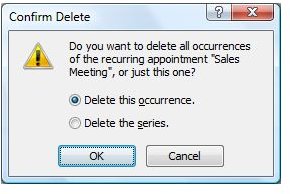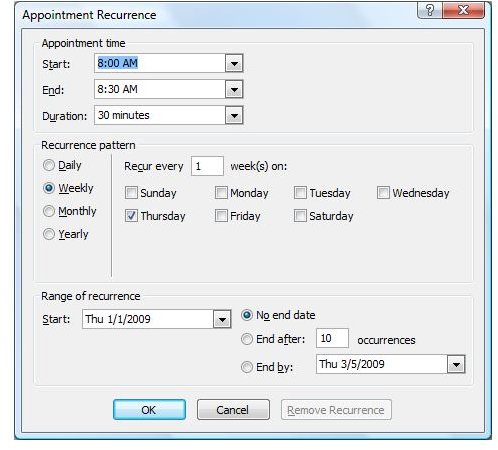Removing Cancelled Appointments in Outlook 2007: How to Delete Future Events in Microsoft Outlook While Preserving Historic Appointments
Deleting Future Recurring Events
Outlook 2007, like previous versions, offer the ability to create recurring appointments in your calendar. An example of such an appointment might be someone’s birthday or a weekly sales meeting that occurs at the same time each week. The granularity available in configuring appointment recurrence should cover almost every likely schedule for a regularly recurring event. Figure 1 shows the window for adding recurrence to an appointment.
Sometimes a recurring meeting is canceled. Or perhaps the user changes departments and no longer attends the weekly sales meetings. If you try to delete a meeting that is part of a recurring series, a prompt asks you whether you want to delete this single occurrence or the entire series. There is no option to remove all future meetings in this appointment series while leaving the historical items in the calendar.
The simplest way to do this is to select a meeting in this series and double click. A prompt will ask if you want to open this occurrence or the entire series. You want to select the entire series here. Click on the Recurrence button in the Message tab of the ribbon. This will open the window as shown again in Figure 1. Here we just need to change the ending date of the series to the date of the last appointment you want saved.
Sometimes in a standard recurring appointment, you add exceptions. Exceptions to not fit in the normal recurring schedule, but are still part of the series. Outlook keeps an exception list which references the base time of the recurrence. If you change the end date of the recurring series the exceptions get recalculated and no longer reflect the desired schedule. If you need to remove future recurring appointments in a series AND keep the exceptions, then the process is a little more challenging.
You can create a separate temporary calendar in Outlook. Then find the recurring appointment in your main calendar and drag and drop it into the temporary one. You need to then export the temporary calender to a .csv file. A .csv file is a text file using Comma Separated Values (CSV). You can open this file in Excel if you need to make any changes or to ensure the calendar was exported fully. When you import the .csv back into the temporary calendar in Outlook, the recurring items are converted to stand-alone appointments and you can then delete the specific appointments you do not need any longer. Finally, drag and drop the appointments you want to retain back into the primary calendar.
Screenshot

This post is part of the series: Microsoft Office Outlook 2007 Tips
A series of Tips and Tricks for working with Microsoft Outlook 2007 both as a user and an administrator.
- New E-mail Account Configuration in Microsoft Outlook: Tip #1
- Use AutoComplete “Nickname” Cache in Outlook: Tip #2
- Configure Outlook Custom Message Views: Tip #3
- How to Configure RSS Feeds in Outlook: Tip #4
- Tip #5 - Making Changes to the Custom Dictionary in Microsoft Outlook 2007
- Tip #6 - Configure Outlook Autosave Settings
- Microsoft Outlook Keyboard Shortcuts: Tip #7
- Microsoft Outlook 2007 Tip #8 - Outlook.exe Startup Switches
- Microsoft Outlook Instant Messenger Addons: #9
- Tip #10 - Using Outlook 2007 to Access GMail
- Showing Full Message Headers in Microsoft Outlook 2007: Tip #11
- How to Re-Send an E-mail Message in Outlook: Tip #12
- How to View Animated GIFs Embedded in an E-mail in Microsoft Outlook 2007: Tip #13
- Telling Outlook How to Handle Messages: Tip #14
- Microsoft Outlook 2007 Tip #15 - How to Color Code the Task List in the To Do Bar
- Tip #16 - Importing from Incredimail to Microsoft Outlook 2007
- Viewing Multiple Outlook Calendars: Tip #17
- Removing Cancelled Future Appointments in Microsoft Outlook 2007: Tip #18
- Tip #19: How to Create New Outlook E-mail from the Command Line
- How to Configure Outlook AutoArchiving: Tip #20
- Using Custom Categories in Microsoft Outlook 2007: Tip #21
- How to Manage Outlook Add-ins: Tip #21
- Microsoft Outlook 2007 Tip #23 - Attachment Previewing Options
